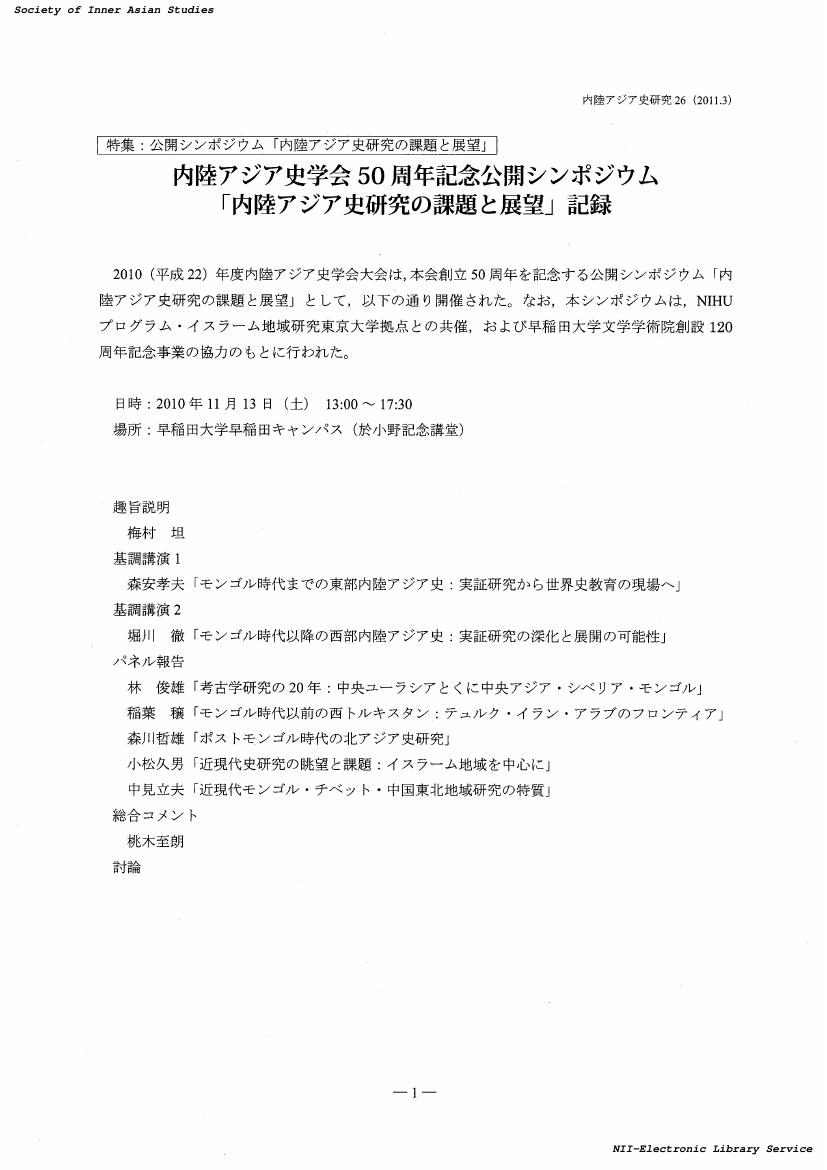- 著者
- 柳澤 明
- 出版者
- 内陸アジア史学会
- 雑誌
- 内陸アジア史研究 (ISSN:09118993)
- 巻号頁・発行日
- vol.27, pp.85-86, 2012-03-31 (Released:2017-10-10)
- 著者
- 赤坂 恒明
- 出版者
- 内陸アジア史学会
- 雑誌
- 内陸アジア史研究 (ISSN:09118993)
- 巻号頁・発行日
- vol.27, pp.86-87, 2012-03-31 (Released:2017-10-10)
- 著者
- 中田 裕子
- 出版者
- 内陸アジア史学会
- 雑誌
- 内陸アジア史研究 (ISSN:09118993)
- 巻号頁・発行日
- vol.27, pp.88-89, 2012-03-31 (Released:2017-10-10)
- 著者
- 中見 立夫
- 出版者
- 内陸アジア史学会
- 雑誌
- 内陸アジア史研究 (ISSN:09118993)
- 巻号頁・発行日
- vol.27, pp.89-90, 2012-03-31 (Released:2017-10-10)
- 著者
- 稲葉 穣
- 出版者
- 内陸アジア史学会
- 雑誌
- 内陸アジア史研究 (ISSN:09118993)
- 巻号頁・発行日
- vol.26, pp.58-63, 2011-03-31 (Released:2017-10-10)
- 著者
- 小松 久男
- 出版者
- 内陸アジア史学会
- 雑誌
- 内陸アジア史研究 (ISSN:09118993)
- 巻号頁・発行日
- vol.26, pp.69-74, 2011-03-31 (Released:2017-10-10)
- 著者
- 中見 立夫
- 出版者
- 内陸アジア史学会
- 雑誌
- 内陸アジア史研究 (ISSN:09118993)
- 巻号頁・発行日
- vol.26, pp.75-80, 2011-03-31 (Released:2017-10-10)
- 著者
- 桃木 至朗
- 出版者
- 内陸アジア史学会
- 雑誌
- 内陸アジア史研究 (ISSN:09118993)
- 巻号頁・発行日
- vol.26, pp.81-84, 2011-03-31 (Released:2017-10-10)
1 0 0 0 OA 8世紀の室韋の移住から見た九姓タタルと三十姓タタルの関係
- 著者
- 白 玉冬
- 出版者
- 内陸アジア史学会
- 雑誌
- 内陸アジア史研究 (ISSN:09118993)
- 巻号頁・発行日
- vol.26, pp.85-107, 2011-03-31 (Released:2017-10-10)
The "Nine Tatars" and the "Thirty Tatars" are tribal names mentioned in ancient Turkic runic inscriptions. However, the relationship between the two is not clear. The "Thirty Tatars" are identified in Chinese historical documents as Shiwei (室韋). A comparative analysis of Chinese sources, ancient Turkic runic inscriptions, and document P.T.1283 found in Dunhuang allows us to conclude that the Jue (鞠) in the Chinese sources correspond to the Cik tribe in the Turkic runic inscriptions and that they resided in the upper reaches of the Kern River. In the mid-8th century, one of the Shiwei tribal groups migrated to the middle reaches of the Selenge River, while another, the Yuzhe (兪折), migrated to the area between lakes Khubsugul and Baikal. These tribal groups of the Shiwei can be identified as the Khe-rged tribes and the seven tribes of Ye-dre mentioned in document P.T.1283, and at the same time as the "Thirty Tatars". As for the name of the tribal group, the "Thirty Tatars", this was in use during the period from the Second Eastern Turkic Khaganate till the Uyghur Khaganate. Under the Tang Dynasty, the notion of the "Thirty Tatars" referred to the Shiwei, which comprised of 26 to 27 tribes. And the "Nine Tatars" referred to a part of the "Thirty Tatars".
1 0 0 0 OA 清代外モンゴルにおける書記の養成 : 東部二盟を中心に
- 著者
- ケレイドジン D・シーリン(錫莉)
- 出版者
- 内陸アジア史学会
- 雑誌
- 内陸アジア史研究 (ISSN:09118993)
- 巻号頁・発行日
- vol.26, pp.109-131, 2011-03-31 (Released:2017-10-10)
This paper examines the scribes' training functions in the banner and league offices in the eastern two leagues-Tusiyetu qan ayimav and Cecen qan ayimav-in Outer Mongolia under the Qing rule as well as the scribes' school established at the minister-office of Yeke Kuriy-e in the late Qing period. Based mainly on historical official documents, the author sheds light on dating the time when the scribes' training was started at the league and banner offices, the methods and contents of education there and, furthermore, clarifies various details related to the scribes' training school of the late Qing period, such as the school management, contents of education and regulations. The conducted research attests to the significance the scribes' training system, established in Outer Mongolia under the Qing rule, had on Mongolian history. This system played an important role in accomplishing the document-based administration in Outer Mongolia. It was also a significant factor in promoting Mongolian culture through spreading Mongolian letters and improving the literacy rate in Mongolian society.
- 著者
- 杉山 清彦
- 出版者
- 内陸アジア史学会
- 雑誌
- 内陸アジア史研究 (ISSN:09118993)
- 巻号頁・発行日
- vol.26, pp.133-142, 2011-03-31 (Released:2017-10-10)
1 0 0 0 OA 編集後記
- 出版者
- 内陸アジア史学会
- 雑誌
- 内陸アジア史研究 (ISSN:09118993)
- 巻号頁・発行日
- vol.26, pp.App1, 2011-03-31 (Released:2017-10-10)
- 著者
- 野田 仁
- 出版者
- 内陸アジア史学会
- 雑誌
- 内陸アジア史研究 (ISSN:09118993)
- 巻号頁・発行日
- vol.25, pp.218-219, 2010-03-31 (Released:2017-10-10)
1 0 0 0 OA 日本モンゴル共同調査ビチェース・プロジェクトの15年 : モンゴル時代の碑文研究・遺跡調査の一端(研究発表・公開講演要旨,2009(平成21)年度内陸アジア史学会大会記事,彙報)
- 著者
- 村岡 倫
- 出版者
- 内陸アジア史学会
- 雑誌
- 内陸アジア史研究 (ISSN:09118993)
- 巻号頁・発行日
- vol.25, pp.219, 2010-03-31 (Released:2017-10-10)
- 著者
- 川口 琢司
- 出版者
- 内陸アジア史学会
- 雑誌
- 内陸アジア史研究 (ISSN:09118993)
- 巻号頁・発行日
- vol.25, pp.219-220, 2010-03-31 (Released:2017-10-10)
1 0 0 0 OA 編集後記
- 出版者
- 内陸アジア史学会
- 雑誌
- 内陸アジア史研究 (ISSN:09118993)
- 巻号頁・発行日
- vol.25, pp.App1, 2010-03-31 (Released:2017-10-10)
1 0 0 0 OA 内陸アジア史学会50週年記念公開シンポジウム「内陸アジア史研究の課題と展望」記録
- 出版者
- 内陸アジア史学会
- 雑誌
- 内陸アジア史研究 (ISSN:09118993)
- 巻号頁・発行日
- vol.26, pp.1, 2011-03-31 (Released:2017-10-10)
- 著者
- 梅村 坦
- 出版者
- 内陸アジア史学会
- 雑誌
- 内陸アジア史研究 (ISSN:09118993)
- 巻号頁・発行日
- vol.26, pp.2, 2011-03-31 (Released:2017-10-10)
- 著者
- 堀川 徹
- 出版者
- 内陸アジア史学会
- 雑誌
- 内陸アジア史研究 (ISSN:09118993)
- 巻号頁・発行日
- vol.26, pp.35-51, 2011-03-31 (Released:2017-10-10)
1 0 0 0 OA 中央ユーラシアにおける考古学研究 : 近20年の中央アジア・シベリア・モンゴル(パネル報告1,<特集>内陸アジア史学会50周年記念公開シンポジウム「内陸アジア史研究の課題と展望」)
- 著者
- 林 俊雄
- 出版者
- 内陸アジア史学会
- 雑誌
- 内陸アジア史研究 (ISSN:09118993)
- 巻号頁・発行日
- vol.26, pp.52-57, 2011-03-31 (Released:2017-10-10)

















